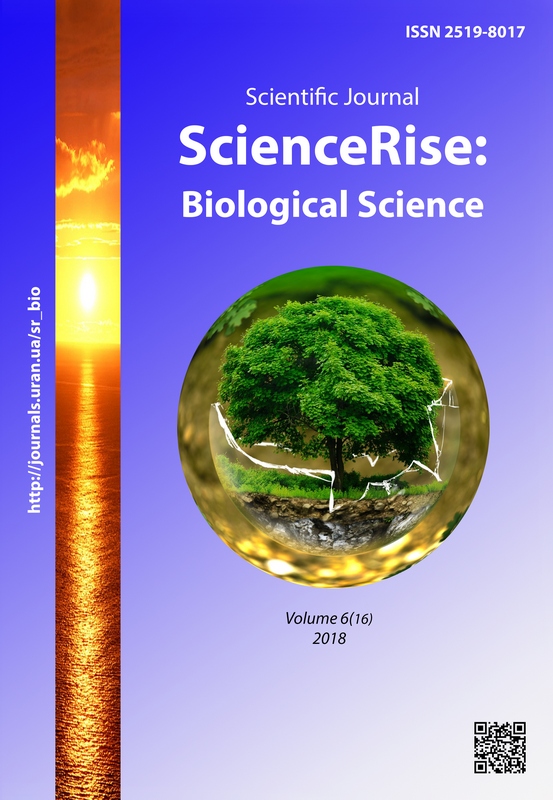Topographic peculiarities of localization of fungi of the genus Candida isolated from sub-biotopes of the oral cavity of practically healthy persons
DOI:
https://doi.org/10.15587/2519-8025.2018.153466Keywords:
Candida fungi, Candida albicans, candidiasis, candidiasis carriage, topographic featuresAbstract
Purpose. Establishment of topographic features of the localization of Candida fungi isolated from the sub-biotopes of the oral cavity of practically healthy persons without clinical signs of candidiasis.
Methods. The following methods are used: microscopic; mycological - cultural studies of biomaterial strains from practically healthy persons; biochemical – for the purpose of species identification of Candida fungi; statistical methods.
Research results. During the experiment, 292 sub-biotopes of the oral cavity are investigated. The material is taken from the mucous membrane of the cheek, the corner of the mouth, the mucous membrane of the surface of the tongue and the palate. According to the results of the conducted research, the level of candidiasis carriage on the oral mucosa in practically healthy individuals without clinical signs of candidiasis is 56.4 %. Candidiasis carrier level on the dorsal surface of the tongue is 38.46 %, the retromolar part of the cheek is 30.77 %, the angle of the mouth is 18.8 %, and the palate is 11.97 %. Among all isolated strains, prevails in all 4 sub-biotopes of C. albicans – 76.07 %. It is noted that in 8 people in the biotope of the oral cavity, but in different sub-biotopes, two species of the genus Candida, C. krusei and C. albicans, are isolated, and in 7 people, C. glabrata and C. albicans. In addition, the coexistence of two candida types is found in 5 sub-biotopes.
Conclusions
1. The level of candidiasis carriage in the oral biotope among practically healthy individuals without clinical signs of candidiasis is 56.4%. The level of candidiasis carriage of the oral biotope in practically healthy persons without clinical manifestations of candidiasis has increased significantly over the past 5 years.
2. Among the identified strains, Candida albicans prevails – 76.07 %.
3. The highest rate of colonization compared with other sub-biotopes is observed on the dorsal surface of the tongue – 38.46%. During the study, the coexistence of two Candida types is revealed. In 8 people in the biotope of the oral cavity, but in different sub-biotopes, two species of the genus Candida, C. krusei and C. albicans, are isolated, and in 7 people, C. glabrata and C. albicans, which confirms the importance of establishing topographic features of the fungi localization in the oral cavity for the rationality of using antimycotics if necessary
References
- Nikolaenko, M. V., Timokhina, T. Kh. (2012). Novyy podkhod k izucheniyu biologicheskoy aktivnosti Candida krusei. Vestnik Tyumenskogo gosudarstvennogo universiteta, 6, 164–170.
- KHmel'nitskiy, O. K. (2000). O kandidoze slizistykh obolochek. Arkhiv patologii, 62, 3–10.
- Popova, A. L., Dvoryanskiy, S. A., Yagovkina, N. V. (2013). Sovremennye aspekty lecheniya i profilaktiki vul'vovaginal'nogo kandidoza (obzor literatury). Vyatskiy medtsinskiy vestnik, 4, 31–36.
- Molokov, V. D., Galchenko, V. M. (2009). Kandidoz polosti rta: uchebn. posobie. Irkutskiy gosudarstvennyy meditsinskiy universitet, 4–5.
- Shcherbak, O. M., Andrieieva, I. D., Kazmіrchuk, V. V., Volkov, H. O. (2011). Chutlyvіst drіzhdzhepodіbnykh hrybіv rodu Candida do novykh pokhіdnykh 4N-pіrydo[4`,3`:5,6]pіrano[2,3-d] pіrymіdynu. Svіt medytsyny ta bіolohіi, 3, 41–44.
- Fedotov, V. P. (2012). Aktual'nye problemy kandidoza (razmyshleniya mikologa-dermatovenerologa – po dannym literatury i sostvennykh issledovaniy). Dermatovenerologiya. Kosmetologiya. Seksopatologiya, 1, 4, 103–128.
- Aylamazyan, E. K., SHipitsyna, E. V., Savicheva, A. M. (2016). Mikrobiota zhenshchin i iskhody beremennosti // ZHurnal akusherstva i zhenskikh bolezniy, LXV, 4, 6–14.
- Shyrobokov, V. P., Yankovskyi, D. S., Dyment, H. S.; Kalpyn, A. H. (Ed.) (2009). Mikrobna ekolohiia z kolorovym atlasom. Kyiv: Typohrafiia NMU, 173.
- Machohan, V. R. (2014). Mikroflora porozhnyny rota ta yii rol u patohenezi heneralizovanoho parodontytu. Visnyk problem biolohii i medytsyny, 4 (4 (116)), 24–28.
- Vrynchanu, N. O. (2016). Kandydoz. Problemy ta perspektyvy antyfunhalnoi terapіi (chastyna I). Farmakolohіia ta lіkarska toksykolohіia, 6 (51), 3–11.
- Pavlenko E. Yu., Ziyadinova M. S. (2011). Mesto kandidozov v infektsionnoy patologi na sovremennom etape. Krymskiy zhurnal eksperrimental'noy i klinicheskoy meditsiny, 1 (2 (2)), 63–66.
- Lesovoy, V. S., Lipnitskiy, A. V., Ochkurova, O. M. (2003). Kandidoz rotovoy polosti (obzor) // Problemy meditsinskoy mikologii, 5 (1), 21–26.
- Miedviedieva, M. B., Matviichuk, N. O. (2012). Oralne kandydonosiistvo u praktychno zdorovykh osib molodoho viku. Naukovyi visnyk Uzhhorodskoho universytetu. Seriia «Medytsyna», 1 (43), 45–47.
Downloads
Published
How to Cite
Issue
Section
License
Copyright (c) 2018 Nadiia Osypchuk

This work is licensed under a Creative Commons Attribution 4.0 International License.
Our journal abides by the Creative Commons CC BY copyright rights and permissions for open access journals.
Authors, who are published in this journal, agree to the following conditions:
1. The authors reserve the right to authorship of the work and pass the first publication right of this work to the journal under the terms of a Creative Commons CC BY, which allows others to freely distribute the published research with the obligatory reference to the authors of the original work and the first publication of the work in this journal.
2. The authors have the right to conclude separate supplement agreements that relate to non-exclusive work distribution in the form in which it has been published by the journal (for example, to upload the work to the online storage of the journal or publish it as part of a monograph), provided that the reference to the first publication of the work in this journal is included.









